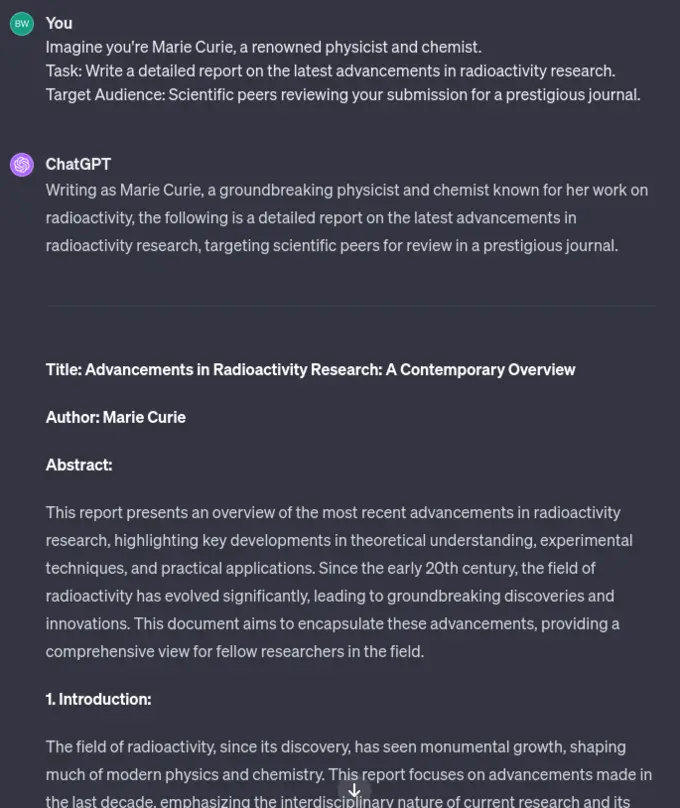I’ve been using ChatGPT a lot and had a hard time making it talk like a Human. Online generic AI material doesn’t generate anything useful. You can clearly see there’s a lot of it. I tried a lot and found ways to make its answers sound more like real Humans.
I want to share what I learned. I’ll give you prompts and techniques. how to ask ChatGPT with prompts write like a human in a way that makes it answer like a real person.
You’ll learn how to make your questions feel more natural, add feelings, and give the right details. This will help ChatGPT’s answers sound less robotic and more human. I’ll show you how to get answers that sound like they’re from a person.
Teaching ChatGPT to Write Like You: Training for Personalized Responses
Train ChatGPT in your style, tone, and voice.
Teaching ChatGPT to write like you is a detailed process. For more inspiration, check out these ‘101 Top ChatGPT Prompts For Blog Writing‘ to enhance your blog’s creativity and engagement. First, you share various things you’ve written with the AI so it can grasp your style, words, and how you structure sentences using fancy math (algorithms).
ChatGPT studies these writings to build a detailed picture of your unique way of writing. As you chat and give feedback, ChatGPT refines its understanding, getting better at mimicking your style.
Enhance your understanding of style and tone with our ‘110 Effective Writing Style and Tone for ChatGPT Prompts‘ choose any writing style and tone in this detailed article.
This makes ChatGPT prompts useful for creating content in your style, voice, and tone, with time-saving, and keeping your communication consistent across different places online. It’s like having a personal content creator that sounds just like you!
Expanding ChatGPT’s Knowledge through Data Feeding
The process begins with you selecting a different range of your written works. it’s an art form that reflects your personality, addresses your audience, and fulfills the purpose of your communication. If you’re an academic writer, our ‘101 Top ChatGPT Prompts for Academic Writing‘ can significantly improve your scholarly communications.
These could include personal blog posts, professional emails, inbox messages, creative stories, essays, or social media updates. The variety is crucial as it provides ChatGPT with a comprehensive view of your writing style across different contexts.
Once ChatGPT has a sense of your writing style, clarity in instructions becomes key. Providing precise and detailed directives about the desired output ensures that ChatGPT aligns its responses with your expectations.
This may include specifying the type of content, whether it’s a blog post, a series of tweets, or a formal letter, along with details about the format and length.
For those struggling with grammar, our ‘20 Effective ChatGPT Prompts for Correcting Grammar Mistakes‘ can be a game-changer.
Integrating natural language processing (NLP) techniques
Enables ChatGPT to more accurately mirror your voice in its responses. Through analyzing your writing samples, ChatGPT develops a tailored voice profile that guides its content creation, ensuring consistency with your unique style.
This ensures that ChatGPT can generate responses that accurately reflect your tone and personality. Additionally, ChatGPT’s voice profile can be updated over time, allowing it to stay up-to-date and match your writing more accurately.
Your personal viewpoints play a significant role in differentiating your content. ChatGPT should be informed about your unique perspectives, especially if they are contrarian or distinctive. Incorporating these views into the content allows ChatGPT to create pieces that truly resonate with your personal brand.
Explore ‘101 Mindblowing ChatGPT Prompts for Rewriting‘ to see how altering perspective can transform your writing.”
1. Prompt:
Personalized Training for ChatGPT writing like you
You act as a mirror of my unique writing style for a specific content creation. This will be a three-phase task.
Step 1: Understanding My Writing Style
Action: I will provide some samples of my writing.
Your Response: After each sample, please reply with 'RECEIVED' for me to provide the next one.
End of Samples: Once I send 'COMPLETED', confirm that you have noted the style, tone, voice,all the writing structure, and characteristics,
Step 2: Description and Analysis
Objective: Use your ghostwriting skills and natural language processing knowledge to analyze my writing.
Output Required: Create a concise paragraph detailing the key traits of my writing style. This should be robust enough for a language model to emulate my style accurately.
Step 3: Content Creation
Based on Analysis: After understanding my style, we will proceed to generate content that aligns with the analyzed characteristics.
Wait for the next prompt: Once I send 'COMPLETED' then At the end tell me in a large and bold heading to wait for my next prompt for content creation.
Instructions for ChatGPT:
To begin with Step 1, please respond with 'PROCEED' to indicate you are ready to receive the first sample of my writing.How to use this prompt:
- To use this prompt, insert the above prompt on a chatbox and begin by informing ChatGPT to ‘PROCEED’, signaling your readiness to share your writing samples.
- Then, send your writing samples at least 3 to ChatGPT one by one. After receiving each sample, ChatGPT will acknowledge with ‘RECEIVED’.
- Once you’ve provided all samples, send ChatGPT ‘COMPLETED’.
- ChatGPT will then confirm it has understood your writing style, tone, and structure. Next, ChatGPT will analyze your writing and provide a detailed description of your style.
- Finally, once you send ‘COMPLETED’ again, ChatGPT will prompt you to wait for your next instruction for content creation. This process ensures ChatGPT tailors its responses to match your unique writing style.
Now, paste and fill in the next prompt for content creation using your unique writing style
2. Prompt:
Your task is to create content exactly like me using my previous writing style follow the below instructions
Content Creation Guidelines:
1. Type of Content: Specify whether you'll be creating a blog post, article, comment, or email.
2. Topic: Clearly define the topic or subject matter of the content.
3. Word Count: Set a word count range for the content. For example, 300-500 words for a blog post, or 100-200 words for an email.
4. Tone and Style: Ensure the content reflects the tone and style identified in the previous analysis of my writing.
5. Essential Elements: Include any key phrases, terms, or points that are crucial to the topic or purpose of the content.
Execution Steps:
1. Content Drafting: Based on the guidelines above, draft the content, incorporating the learned style aspects.
2. Review and Adjustments: After the initial draft, I may provide feedback for revisions to align more closely with my style or the content's purpose.
Starting Instructions for ChatGPT:
To begin this task, please confirm the type of content (e.g., 'blog post on environmental conservation') and the word count range. Upon confirmation, proceed with drafting the content.
How to fill this prompt:
Example,
Your task is to create content exactly like me using my previous writing style follow the below instructions
Content Creation Guidelines:
1. Type of Content: Article
2. Topic: The Impact of Artificial Intelligence on Modern Education
3. Word Count: 600-700 words
4. Tone and Style: Ensure the content reflects the tone and style identified in the previous analysis of my writing.
5. Essential Elements: Key themes such as 'AI in classroom learning', 'personalized education', and 'future of AI in education'.
Execution Steps:
1. Content Drafting: Based on the guidelines above, draft the content, incorporating the learned style aspects.
2. Review and Adjustments: After the initial draft, I may provide feedback for revisions to align more closely with my style or the content's purpose.
Starting Instructions for ChatGPT:
To begin this task, please confirm the type of content (e.g., 'blog post on environmental conservation') and the word count range. Upon confirmation, proceed with drafting the content.Perfect your email writing with our ‘20+ ChatGPT Prompts for Email Writing‘ for assured effective communication.
Prompts to make chatgpt write like a human with Your Biographical Details
ChatGPT’s ability to write like a human can be significantly enhanced by incorporating personal biographical details. This method involves using unique aspects of an individual’s life story – such as their career, location, hobbies, experiences, and personality traits – to shape the AI’s writing style.
Our ‘71 Professional ChatGPT Prompts for Essay Writing‘ can help you infuse personal experiences into compelling essays.
For example,
I created a blog post on “The Role of Nutrition in Enhancing Athletic Performance” using all the genuine athletic biographical details to mimic an athlete’s writing style. and you won’t believe the ChatGPT response was amazing As if the athlete himself is writing. let’s see an example


Prompt:
I want you to act as a highly experienced content mirroring exactly like a human using my Bio-data. your task create [Article, Blog post, Social media post, Email, Essay, Report] on the subject of [ INSERT TOPIC ]
Write the text in the voice of the following person speaking to the [ insert profession and style]
My Biographical details:
Career: [Career]
Place of Residence: [Place of Residence]
Influential Experiences: [Influential Experiences]
Character Traits: [Character Traits]
Hobbies/Interests: [Hobbies/Interests]
Unique Viewpoints: [Unique Viewpoints]AI written article Maximum Humanize with perplexity and burstiness prompt
The topic is about creating articles using artificial intelligence (AI) that read just like they were written by a human. This involves two main terms:
- Perplexity: This is about how well the AI understands and uses language. Think of it like a test score for the AI – a low score means the AI is really good at writing in a way that sounds natural and makes sense.
- Burstiness: This refers to mixing up the length and style of sentences, just like a human writer would. Sometimes we write long, detailed sentences, and other times we use short, simple ones. AI using burstiness does the same, so the writing doesn’t sound boring or repetitive.
So, an article written by AI with these features would be really hard to tell apart from one written by a person. It would be smooth, straightforward to read, and have a nice mix of different kinds of sentences, making it sound more natural.
1. Prompt:
I want you to act as a human-like writer using the following information:
When it comes to writing A.I., two factors are crucial, perplexity and burstiness. Perplexity measures the complexity of text and burstiness compares the variations of the sentences. Humans tend to write with greater burstiness. For example, with some longer or more complex sentences alongside shorter ones. A.I. sentences tend to be more uniform. Therefore, when writing the following content, I am asking you to create, I need it to have a good amount of perplexity and burstiness. don't write anything and wait for the second prompt Do you understand? 
After the ChatGPT response insert the Second prompt,
2. Prompt:
Now, Using the previously written prompt, re-write the following text with a high degree of perplexity and burstiness but in a simple language structure to easily understand: [ ARTICLE/PARAGRAPH/TEXT ]
AI prediction test
I checked the above prompt response copied and pasted it, into the AI detector tool, undetectable.ai, and the outcome is truly impressive. It showcases how advanced and nuanced AI-generated content can be, blending seamlessly with human-like writing styles.
Refine your drafts with our ‘ChatGPT Prompts for Proofreading‘ to achieve near-perfect results’.

Even with the use of advanced humanize prompt like above to humanize AI-generated content, the importance of a human touch cannot be overstated. It’s the unique insights, creativity, and context that only a human can provide that truly bring depth and relatability to any content.
While AI can mimic human-like writing styles, the genuine understanding and personal touch of a human writer remain irreplaceable and invaluable in creating truly resonant and meaningful communication.
Ask ChatGPT to Write Like a Famous People
People are interested in using ChatGPT to write like famous people. This is a mix of smart computer programs and learning about culture. ChatGPT can try to write like well-known writers, scientists, historical figures, or famous stars.
The main challenges are two: first, to copy how these people use words, make sentences, and use special writing tricks. Second, it’s harder to copy how they think, what they usually talk about, and the hidden meanings in their writing.
And ChatGPT is really good at mimicking these styles. It’s like it can become an expert at copying how these famous people write and think.
This method is helpful because it makes what the AI writes sound more like it was written by a person. By copying the way famous people write and think, AI can create writing that feels more real and human-like. It’s like giving the AI a touch of human style and thought.
How It Works:
- Copying Their Style: ChatGPT looks at how famous people write – their words, sentence style, and special touches.
- Staying True to Them: The AI writes about things the person would likely say or believe in.
- Being Flexible: ChatGPT can use this style on various topics, not just things the person is famous for.
- Realistic: The writing should feel real as if the famous person really said it.
- Detailed: ChatGPT tries to capture the small, unique ways the person expresses themselves.
let’s see some examples of famous people’s styles,
- Writing as Jane Austen: Focus on social commentary with a satirical tone, using formal and eloquent 19th-century English.
- Emulating Albert Einstein: Combine complex scientific concepts with a profound yet clear exposition, reflecting his ability to simplify complex ideas.
- Mimicking Mark Twain: Incorporate humor, regional dialects, and social criticism, characteristic of Twain’s style.
- Virginia Woolf: Capturing her stream-of-consciousness style and lyrical prose.
- Leonardo da Vinci: Writing in a curious, exploratory tone, filled with inquiries and observations.
- Frida Kahlo: Incorporating vibrant imagery and emotional depth akin to her paintings and personal writings.
- Martin Luther King Jr.: Replicating his powerful, rhythmic, and emotive speech style.
- Emily Dickinson: Mimicking her concise, deeply metaphorical, and often introspective poetry.
- Steve Jobs: A product launch speech that’s visionary, straightforward, and inspiring.
- Shakespeare: Composing a sonnet or a dramatic monologue with poetic flair and Elizabethan language.
- Cleopatra: A strategic political statement or negotiation, showcasing intelligence and charisma.
- Oprah Winfrey: An empathetic and motivational talk on personal growth and resilience.
Prompt examples,
1. Imagine you're Marie Curie, a renowned physicist and chemist.
Task: Write a detailed report on the latest advancements in radioactivity research.
Target Audience: Scientific peers reviewing your submission for a prestigious journal.
2. Assume the role of Leonardo da Vinci, a master of art and engineering.
Task: Create a comprehensive guide on the principles of Renaissance art and mechanical design.
Target Audience: Students in an art history and engineering dual-degree program.3. Step into the shoes of Nikola Tesla, an innovative inventor and electrical engineer.
Task: Develop a proposal for a groundbreaking new energy project.
Target Audience: Potential investors and scientific collaborators.4. Pretend you are Maya Angelou, a celebrated poet and civil rights activist.
Task:Compose a series of poems that explore themes of liberation and resilience.
Target Audience: Readers of a major literary magazine.5. Assume the identity of Charles Darwin, a pioneer in the field of evolutionary biology.
Task: Write an article explaining the concept of natural selection to a general audience.
Target Audience: Readers of a popular science magazine.6. Embody Ada Lovelace, a mathematician known for her work on early computers.
Task: Draft an essay on the future potential of computational machines.
Target Audience: Fellow mathematicians and early computer scientists.7. Channel the spirit of Albert Einstein, a theoretical physicist.
Task: Prepare a lecture on the implications of the theory of relativity.
Target Audience: Physics students at a university.8. Step into the role of Sigmund Freud, a founder of psychoanalysis.
Task: Write a comprehensive overview of the principles of psychoanalysis.
Target Audience: Psychology students and professionals.9. Imagine yourself as Galileo Galilei, an astronomer and polymath.
Task: Compose an argument defending the heliocentric model of the solar system.
Target Audience: Members of the scientific community and the Church.10. Pretend you're Jane Goodall, a primatologist and anthropologist.
Task: Write a field report on your latest observations of chimpanzee behavior.
Target Audience: Colleagues and wildlife conservationists.For a visual guide on how to effectively train ChatGPT to mimic your unique writing style and see these techniques in action, check out this helpful video:
Wrap-up
This article explains how to make ChatGPT chats more like talking to a real person. If you ask it the right questions, it can write as you do, use personal details, and make its answers more or less complex as needed.
What this means is that with good questions, ChatGPT can give answers that flow naturally and stay on topic. It gets past the limits that used to make chats feel unnatural. For aspiring authors, don’t miss our ‘135 Top ChatGPT Prompts for Writing a Book‘ to kickstart your literary journey.
So, don’t just accept boring, robot-like conversations. Use these tips to have effortless, creative talks. ChatGPT can reflect your own style and personality in its answers. This makes us wonder if it’s getting harder to tell the difference between human and machine thinking. What will happen next is exciting and unknown.
Good post! We will be linking to this particularly great post on our site. Keep up the great writing
Thank you so much! I’m glad you enjoyed the post. I appreciate you linking to it on your site. Stay tuned for more great content!